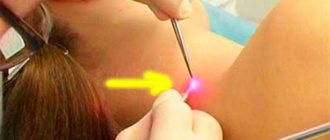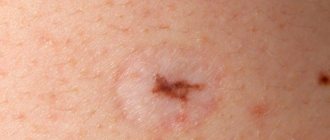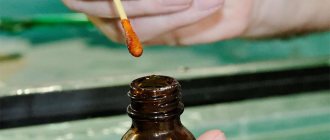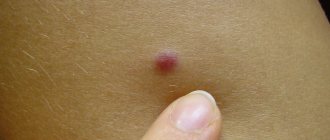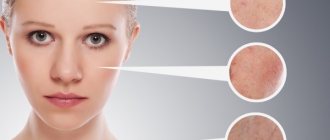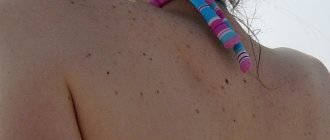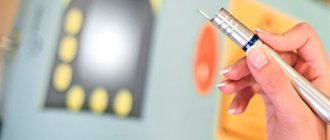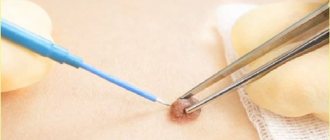Mole removal
Despite the fact that moles belong to the category of benign neoplasms, their removal should be carried out only after a complete examination of the patient’s body. This is explained by the fact that the procedure is characterized by the presence of certain contraindications. It is not recommended for patients diagnosed with allergic reactions to medications. Melanoma is a contraindication to manipulation. In case of excessive tanning, it is recommended to avoid the procedure.
Removal is not carried out if the patient experiences the development of inflammatory processes on the skin. During the period of herpetic infection, manipulation of the patient is strictly prohibited. If a person has melanoma, then the mole, as well as the affected tissue, is removed. In this case, it is necessary to have an integrated approach to treatment. Before carrying out the procedure, it is recommended to consult with an oncologist.
There are several methods for removing moles. If the tumors are small, then a laser must be used to eliminate them. A laser beam is used to evaporate a specific area. This intervention is absolutely safe, since it does not affect healthy skin. Laser treatment is characterized by a quick recovery period and a minimum number of unwanted effects.
For large moles that protrude above the skin, surgical intervention using a scalpel or knife is recommended. In most cases, such neoplasms are characterized by the presence of a subcutaneous body, which is supplied by blood vessels. Despite the fact that a small scar remains, this method makes it possible to completely remove the mole. To remove flat moles, liquid nitrogen is often used, which is characterized by the presence of a freezing effect. After the manipulation, a crust forms, which disappears on its own.
Moles can be removed using various methods. The choice of a particular one directly depends on the type and size of the tumor, as well as the individual characteristics of the patient.
Is it possible to remove moles?
Benign age spots in themselves are not dangerous as long as they retain a clear shape, remain flat and have a characteristic brown color. Some of them begin to grow over time. There is nothing supernatural about this either. Most people try to remove a mole when it attracts attention, is located in the face, neck, cheeks, around the eyes and spoils the appearance in life and in photos.
Some lesions are warts or seborrheic keratoses. Do moles of this kind need to be removed? A dermatologist treats them by freezing or cauterizing, but dangerous nevi can only be removed surgically when there are special indications for this:
- increase in growth in size;
- color change (discoloration, redness, streaks);
- change of form;
- the appearance of itching;
- bleeding
Features of care
The healing process after mole removal is quite long and complex. That is why during this period it is necessary to provide appropriate care for her. Healing after laser mole removal takes place in several stages:
- In the first week after surgery, a dark crust appears. It is strictly prohibited to remove it mechanically. This is explained by the fact that the wound protects the wound from infection. During this period, it is necessary to treat the removal site as carefully as possible. It is strictly forbidden to damage it. After consultation with a doctor, the crust can be treated with a disinfecting solution. Also in this case, ointments that are developed on the basis of an antibiotic are used.
- After a week, the crust disappears. In its place remains the skin of a soft pink color. In this case, the skin is protected from ultraviolet radiation. That is why during this period it is necessary to protect the skin from exposure to sunlight. Before going outside, the operated area is lubricated with sunscreen.
- After 3 weeks, the formation of healthy skin at the site of the nevus is observed. If the wound has completely healed, then there is no need to provide special care for it. If during this period, despite the healing of the wound, the appearance of skin itching is observed, then it is necessary to use special soothing ointments. Only a doctor knows how to treat a mole after removal. That is why the specialist must determine the remedy in accordance with the characteristics of the operation.
During the period of care, a person should know how healing proceeds after removal of a mole, what should not be done? If the nevus was on the face, then patients are strictly prohibited from using decorative cosmetics for a week. Patients are strictly prohibited from drinking alcoholic beverages for 5 days after the procedure. This is explained by the fact that after drinking alcohol, vasodilation is observed, which can lead to bleeding.
How long a mole takes to heal after removal depends on the patient’s behavior. If he strictly adheres to the rules of the rehabilitation period, then complete healing is observed within a month. Patients are strictly prohibited from visiting the pool and sauna for 14 days after the procedure. If this rule is followed, a secondary infection will not develop. Patients are not recommended to visit beaches and solariums within a month after the intervention.
If proper care is provided for the mole after removal, then healthy and full-fledged skin will remain in its place.
Care for 10-14 days after the procedure
A mole has been removed - how to treat it, and how does the wound heal? Most often, 2 weeks after excision, the existing crust disappears, and in its place a new thin pink skin remains. Then you should definitely use a wound-healing ointment: “Actovegin”, “Rescuer” cream or “Levomekol”. They are used for 10-14 days.
By the end of 3 weeks everything is usually healed and treatment is stopped. But with increased sensitivity, itching may persist, and the doctor may prescribe special creams with an antipruritic effect: Sinaflan, Beloderm and their analogues. They often relieve itching immediately, from the first use.
Reparative processes are accelerated with the help of vitamin-mineral complexes, creams with hyaluronic acid, and the use of peelings.
Complications and consequences
If a person does not know what to do after removing a mole and does not properly care for it, this can lead to a variety of undesirable consequences. When an infection occurs, purulent discharge from the wound appears. Some patients were diagnosed with bleeding. If there is an infectious process in the operated area, this can lead to an increase in body temperature. Some patients complained that the wound became very wet and itchy. If all of the above symptoms appear, you should immediately seek medical help.
After removal, swelling of the skin in the intervention area may be observed. In this case, the patient should not worry, as the symptom goes away on its own within 2 weeks. If the nevus is not properly cared for, certain deviations in the rehabilitation period may occur, which requires taking additional measures for treatment. In most cases, complications manifest themselves as:
- Relapse. In this case, the mole appears again in the same place. This condition is possible if not all nevus cells were removed during the procedure. This condition is not harmful to health. The patient just needs to be regularly monitored by a specialist. If a mole reappears, it can be removed.
- Hypertrophic scar. It is a depression that appears at the site of a mole. The cause of the pathological condition is the low rate of regeneration processes. A scar is a cosmetic defect that is not sufficiently pronounced. In this case, intervention is not recommended, as it can smooth out on its own.
- Hypopigmentation. A white spot may form at the site where the mole was removed. This complication is observed when the mole is located in the deep layer of the epidermis. It can also occur if, during the rehabilitation period, the site of mole removal was exposed to ultraviolet radiation. The neoplasm does not need correction. It can go away on its own within two years.
- Hypertrophic scar. If the healing of the wound after removal of the mole does not occur correctly, then a bulge is observed in its place. In most cases, the bulge smooths out on its own within 6 months. If the bulge does not go away, then the patient is indicated for treatment with medications, as well as additional cosmetic procedures.
After removal of a mole, the patient must strictly adhere to the rules of the rehabilitation period. Otherwise, this may lead to a variety of undesirable consequences.
Solution of potassium permanganate and "Fukortsin"
Antiseptic solutions are intended to prevent suppuration of the place where the mole was removed. What to process? More often than others, potassium permanganate and Fukortsin are used. Potassium permanganate or potassium permanganate is a strong oxidizing agent and even when diluted retains its properties. The potassium permanganate solution should be 0.1-0.5%. This means consumption of 6-8 of its crystals per liter of water. It should be poured into a glass container and be warm. If it is impossible to count, make the solution “by eye” - after mixing it should have the color of red wine.
The need and features of mole removal
| Removal Features |
| A nevus is a collection of cells that produce the melanos pigment. A mole is a benign formation that has a risk of transforming into cancer. |
Laser removal is considered a popular and widespread procedure, but other methods and techniques for eliminating nevi also have the right to life.
- Laser (layer-by-layer removal of moles).
- Cryodestruction (liquid nitrogen at -180°C).
- Electrocoagulation (burning with electric current using an electric knife).
- Surgical method (excision of brown formation in a hospital setting).
- Surgitron (based on the action of radio waves and created to remove various skin formations).
It is necessary to seek advice from a doctor who is competent to determine the possible presence of affected areas of the dermis. After the necessary medical examination, it is possible to choose the most rational method for removing the nevus. In some cases, doctors do not advise eliminating a benign tumor; the results may lead to complications.
Typically, wound healing after any mole removal takes a period of two to four weeks.
Melanin is a special pigment produced by special skin cells called melanocytes. It is a natural dye in the body that is responsible for the color of hair, eyes and skin.
- When a mole is located in a vulnerable place, is subject to constant friction against clothing, hurts, is injured (at the time of a haircut, shaving on the head, under the armpit) - it is necessary to get rid of them; due to constant damage, the nevus acquires a tendency to malignant degeneration.
- When there is a real threat of transformation of a benign tumor into a malignant one. The growths must be removed immediately.
What else is electrocoagulation used for?
The practice of electrosurgery has become firmly established in medicine since the mid-twentieth century. Today it is actively used not only for the removal of moles, warts, papillomas, and capillary mesh. With its help in gynecology, localization and healing of erosive areas of the cervix are successfully carried out; in ENT practice, papillomas are cauterized, the growth of which narrows the lumen of organs.
In neurosurgery, thrombosis of blood vessels is performed using a heated current probe, in proctology, cauterization of hemorrhoids is actively practiced, and in dentistry, drying of cells in case of gum inflammation. Thanks to the use of the described technique, it is even possible to remove tattoos from the body. And even though this is a painful process, it helps to quickly, effectively and completely safely get rid of many cosmetic defects.
Rules for caring for a wound after removal
For quick healing of wounds after eliminating the formation, it is important to follow simple rules. After the nevus is eliminated, the attending physician will leave special care instructions. The course of rehabilitation depends on the method of eliminating the formation.
| Need for removal |
| Benign tumors should be disposed of in the following cases: |
| What measures to take on the first day after surgery. | Treat the wound with a weak manganese solution, which reduces the risk of infection and dries out the resulting crust. |
| How to care for a removed nevus after surgery | Use of antiseptics and antibiotics. Special creams and ointments to avoid complications that arise after treatment. |
| What else do you need to know | In summer, it is important to protect the wound from sunlight. |
When removing a mole from the face, the doctor prescribes a treatment method individually.
Stages of mole healing
Subject to strict adherence to the rules of care in the area of nevus removal, the dermis is completely tightened and heals after three to four weeks, the color of the skin becomes uniform. You can forget about scars if you follow all the rules for caring for the wound area. You can speed up the healing process if you properly treat wounds after mole removal.
| What time of year is it best to postpone surgery? | The recommended period for nevus extraction is autumn and winter. |
| Stage I |
(First 7 days)
(7-14 days)
(day 20+)
Bandage or patch
A mole has been removed - how to treat the wound? In addition to antiseptic solutions, the main attributes are plasters and bandages. Today, instead of the usual bandages and adhesive plaster, special devices are used that not only protect the wound, but also promote rapid healing.
If a mole has been removed, what should I use to treat it? Care may be as follows - Mepiform silicone patch - created specifically for the resorption of hypertrophic and keloid scars. Available in different shapes and sizes. The treatment period for such scars is long, up to 8 months.
How long will it take to heal?
When a mole is removed using the laser method, in addition to a scar, a small burn remains on the skin. The healing process will take longer.
In other options, the nevus heals faster. After a few days, a dry crust forms, which performs a protective function and cannot be injured or torn off. When the crust itself comes away from the skin, a light spot will remain.
The most problematic areas for healing are the armpits, folds of the skin, and parts of the body covered with hair (including the groin). It is necessary to handle with greater frequency and, if possible, leave it open to avoid damage.
The duration of healing depends on the size and depth of the nevus legs. The maximum healing period is from 7 to 20 days. A small pigment spot may disappear within 3 days.
What to do if the wound does not heal
If the wound bothers you in the first days after mole removal, the redness scares you, or suppuration has begun, there may be two root causes:
- Penetration of pathogenic microorganisms into the wound during surgery or when a chronic inflammatory process within an individual’s body worsens.
- Failure to comply with hygiene rules.
If the scar does not heal at all and has an unpleasant appearance, you can think about special silicone patches and preparations that help smooth the skin.
What to do about scars
A scar or scar after mole removal occurs when the mole is large or deep, even with proper care. For the most part, scars gradually dissolve or become invisible.
To combat them, special reusable silicone-based patches have been created. After application, it is worn for a long time. It is believed that the mechanism of the positive effect on the scar in such cases is based on the fact that the bandage puts pressure on the scar and thromboses the vessels at the site of the lesion, the scar stops receiving nutrition, and as a result it decreases.
If the scar is rough and unaesthetic, you can resort to plastic surgery, but the result is not guaranteed. Some patients complain of the growth of a mole at the site of removal. This phenomenon can occur if it is not completely removed. This may be dangerous and a doctor's consultation is required.
When to see a doctor and possible complications
You should seek help from a doctor in the following cases:
When a nevus seems suspicious:
- color changes;
- dimensions over 1 cm.
Dangerous transformation of a mole for human life:
- huge size;
- blood or ichor oozes from the nevus.
| Formation of a crust, which is strictly prohibited from being removed. Its function is protective, protecting the wound from infection. Under the cover, the epithelial tissue grows more actively and tightens. | |
| Important! | In the first seven days, protect yourself from injuries and damage - do not scratch, avoid contact with cream or other cosmetics. |
| Stage II | |
| At the second stage, the crust dries out, peels off from the dermis, and a new skin with a light pinkish tint remains in its area. | |
| Important! | Do not expose the affected area to ultraviolet rays. To this end, use sunscreen with a high SPF level and avoid direct contact with the sun's rays, and postpone going to the solarium. |
| Stage III | |
| The hole is smoothed out, and the skin does not require further special care. | |
| Complications after mole removal using different methods | |
| Methods | Complications |
| Laser |
|
| Cryodestruction (removal using liquid nitrogen) |
|
| Application of a radio knife (radio wave surgery) |
|
| Surgical |
|
The presence of nevi and birthmarks on the body is a reason to regularly consult a dermatologist. Melanoma is increasingly becoming the cause of death in people of all genders, ages and conditions. Any change in education should be alarming.
All iLive content is reviewed by medical experts to ensure it is as accurate and factual as possible.
We have strict sourcing guidelines and only link to reputable sites, academic research institutions and, where possible, proven medical studies. Please note that the numbers in parentheses ([1], [2], etc.) are clickable links to such studies.
If you believe that any of our content is inaccurate, out of date, or otherwise questionable, please select it and press Ctrl + Enter.
If a mole does not cause inconvenience, then they do not even pay attention to it. But if it increases in size or is located in an area that is more often subject to injury, removal of moles with a laser is a necessary measure. Moreover, they can become the cause of human malignant formations.
Possible consequences
In some cases, the healing process may occur with some deviations from the norm, which can be eliminated with additional procedures. Such deviations are the following situations:
- Nevus recurrence (reappearance of a mole) is possible if not all cells of the mole were removed during the procedure and some microscopic nevus particles remained in the same place. This situation does not pose any health risk and requires only observation. If a mole grows back, it can be removed again if desired;
- Hypopigmentation is the appearance of a white spot at the site of removal. This cosmetic defect is possible if the removed tumor is located in the deep layers of the skin. Also, sunbathing during the prohibited period can lead to the appearance of hypopigmentation. In any case, the resulting white spot does not require medical correction and will go away on its own in 1.5-2 years;
- A hypotrophic scar is a depression at the site of a removed tumor that occurs due to the low rate of tissue regeneration. A deep scar is an inconspicuous cosmetic defect and does not require any intervention, as it gradually smoothes out on its own;
- A hypertrophic scar is a bulge at the site of a coagulated mole, which may have a darker color than the surface of the skin. If the raised scar does not smooth out on its own after 3-6 months, then the doctor may prescribe drug therapy or additional cosmetic procedures to eliminate it.
Moles are quite unpleasant new growths that bring discomfort to a person. If they pose a threat to human health, then they are removed cosmetically. In order to ensure complete healing after mole removal, it is necessary to provide proper care after it has healed.
Indications
Whether it is worth resorting to such a method as laser mole removal is determined by a qualified specialist. If you feel discomfort in the place where the nevus is located, you should immediately consult a dermatologist. The greatest danger that a birthmark poses to any person is its degeneration into a malignant tumor - melanoma. Timely elimination will prevent the development of a dangerous disease. There are a number of indications for removing moles with a laser:
- the neoplasm has a glossy tint;
- the natural pattern of the dermis disappears, the relief of the mark is smoothed out;
- the edges become uneven, asymmetry is observed;
- the nevus increases in volume over a short period of time;
- burning, itching, peeling, dry crust formation;
- the hair that grew on the surface of the mole falls out;
- formation of nodules, weeping surface, growths;
- bleeding, as a result of injury or spontaneously;
- the death of an old mole, but the appearance of a new one in the same place.
Preparation
No special preparation is required before the laser mole removal procedure. At this stage, it is enough to undergo an examination by a dermatologist, who will study the structure of the nevus and indicate its type, and an oncologist. Consultation with the latter is necessary in order to determine whether the formation on the skin is malignant. And is it a consequence of cancer in the patient? To do this, he prescribes a series of tests to exclude or confirm assumptions.
The doctor also tells the patient about the features and advantages of laser mole removal, points out the disadvantages and possible undesirable effects. Conducts a test to identify allergies to laser exposure. Gives recommendations for skin care after the birthmark is removed. Direct action should be taken only after the specified specialists have established the nature of the pathology and approved the operation.
Contraindications and restrictions
The malignant nature of the mole is not the only contraindication to the use of the described technique for removing nevi. It should not be used if the patient has:
- poor blood clotting,
- allergy to anesthetic drugs,
- viral diseases in the acute phase,
- skin hypersensitivity.
Electrocoagulation is not used even when the size of the formation is more than one centimeter.
Technique
Laser mole removal is a method of precise step-by-step removal of layers from a pigmented formation on the skin using an ablative laser. The procedure will take less than ten minutes. First, a pain-relieving injection, so-called local anesthesia, is injected into the area around the mole. The patient has the right to refuse it if the nevus is small and the person has a low pain threshold. The doctor then directs the laser beam to the pathological area of the skin. All the force of influence will be directed exclusively at the neoplasm, from which all layers will be gradually removed.
If the mole is large, it will have to be removed in several stages. But, despite the fact that the problem was eliminated immediately or it took two or three procedures, no scars remain on the patient’s body. In addition, it is worth noting that another qualitative characteristic of the presented method is that there is no bleeding and the recovery process occurs in a short time. Removing moles with a laser does not involve contact of the skin with the instrument; the sterility of the method eliminates the risk of wound infection, the introduction of any type of hepatitis virus and HIV infection.
[1], [2]
Laser removal of moles on the face
If moles are small in size, do not cause inconvenience and are located on those parts of the body that can be easily hidden by clothing, then their presence can still be tolerated. But when the nevus is in the most visible place - the face and is the cause of a person’s discomfort, then one should begin to solve this problem. Women react especially painfully to this fact, since they are the ideal of beauty. If this sign does not make them more attractive, then they strive to get rid of it without fail.
The most effective method is laser mole removal, which is also used to eliminate pathology on the facial part of the head. You should not be afraid of the appearance of scars and other unpleasant signs. If the procedure is carried out by a qualified specialist, then after a certain time there will be no traces of the mini-operation left. The main thing is to behave correctly during the rehabilitation period, namely to protect the operation area from direct ultraviolet rays. Cover it with a band-aid and, if possible, stay out of the sun as little as possible.
Removing red moles with laser
Most patients are concerned with the question: is it possible to remove red moles? Their medical name is angiomas. The reason for their occurrence is a malfunction of the vascular system. Small red dots grow from blood vessels and reach the surface of the epithelium. It is forbidden to get rid of them yourself. Laser removal of red moles is one of the most effective methods today. It is best to deal with them at the initial stage of development. And to solve the problem you will need a small number of procedures.
It happens that after the first irradiation the angioma disappears. But when a network of capillaries forms around it, treatment becomes more difficult. Elimination of the central arteriole alone will not produce results, since the vessels extending from it also receive blood through extensive collateral connections. Therefore, a series of procedures is necessary to completely remove the problem. The removal process itself is no different from other types of moles. And as a result, you will get clear skin, since the laser beam acts exclusively on the blood vessels.
There may be marks and unsightly holes. PHOTO
Because of the sun (I love sunbathing) and heredity, moles appear periodically. I don’t like them, so I always try to remove them.
Lately they have accumulated more, since I was pregnant, and during this period they cannot be removed.
Six months have passed since I gave birth, and it’s time to run to a cosmetologist.
It takes literally a few seconds to remove one mole. Therefore, the procedure time depends solely on their quantity.
The small ones were removed without pain relief, but if the larger ones were removed, the doctor gave an injection.
After the operation, a wound remains at the site of the mole, which the doctor will treat with an antiseptic.
Further, you should not touch it, pick it, or tear off the crust that has formed. It is not recommended to wet the first days.
At home, I wiped these areas with calendula tincture 2-3 times a day.
I removed it on my hand, so I wore rubber gloves for a couple of days before contacting water.
The healing process is quite long. The larger the mole, the longer this period.
Moreover, it also depends on the area where the mole was.
The scabs on my back and neck fell off within a week. The red spots remained almost invisible.
But on the face and hand the situation is different.
The scabs on my hand did not fall off for almost 3 weeks.
It completely disappeared on my face after 2 weeks.
Contraindications to laser mole removal
There are not many special contraindications for removing moles with a laser, so this method is used most often. Still, it should be avoided by those people who are allergic to laser radiation. In this case, redness of the skin will be observed in the affected area. And with very sensitive skin there is a risk of blisters.
It happens that pigmentation changes, but soon everything returns to normal. You should also not use a laser if you have skin diseases, rashes of any degree around the mole, malignant nevus, or weak immunity. The procedure is also contraindicated for patients with psychological diseases, with a diagnosis of oncology, since it will be difficult to foresee the consequences, with diabetes, because the skin does not regenerate well.
Laser mole removal is strictly not recommended for women during pregnancy, as it is during this period that they are especially vulnerable. If getting rid of a nevus is not possible using the indicated method, then your doctor will choose an equally effective one, but do not try to get rid of it yourself.
Treatment of postoperative scars
Postoperative lumps are difficult to treat. Getting rid of a scar or scar will require patience and time . It is better to monitor the condition of the wound in the first months after the operation than to get rid of the consequences afterwards.
To eliminate a cosmetic defect, which is a scar, a specialist may prescribe:
- Drug therapy with the use of immunostimulants and corticosteroids that affect collagen formation;
- Use of pressure bandages with special ointments or silicone patches;
- Carrying out cosmetic surgery in the presence of a tubercle, scar or keloid scar (laser resurfacing, re-operation).
It is strictly not recommended to prescribe treatment for yourself. Only a doctor in a clinical setting can assess possible risks and get rid of negative consequences, the most dangerous of which is malignant degeneration of cells.
Consequences after laser mole removal
It is necessary to ensure that this small but important operation for the patient is performed exclusively in a medical facility by an experienced specialist. Many surgical interventions can have undesirable consequences, no matter how reliable it is. Laser mole removal was no exception. Naturally, every person will do his best to avoid negative consequences. To prevent them, you should strictly follow your doctor's instructions on the use of medications and wound care and immediately go to the hospital if:
- after the mini-operation, discharge of an unknown nature began to appear,
- extensive redness of the skin,
- severe itching
- the temperature rises,
- the crust on the wound remains longer than expected,
- the area affected by the laser beam is swollen.
Of course, this rarely happens, because laser mole removal ends very successfully. Minor redness and crusting are integral factors of laser surgery and should not cause concern. Only those people who neglect the doctor’s recommendations and follow them in bad faith will have a negative result.
[3], [4], [5]
Black spot after laser mole removal
The doctor tells the patient in advance about all the possible consequences that arise after removing moles with a laser, as well as about spots. After the nevus is eliminated, a black spot may remain. It is formed at the end of the procedure, regardless of which method was used. It is a kind of crust that serves as a protective barrier to the wound, preventing the entry of viruses and pathogens from the environment. After the damaged area heals, it will fall off and a pink spot will remain in its place, which will disappear without a trace within six months. This development of events indicates that the skin is recovering normally.
Normal recovery after surgery
If the intervention is performed by an experienced specialist, then the wound healing process proceeds normally. All you need is time and proper care.
- In the first week, a crust forms. The most important thing is not to touch her. In the first few hours, the wound may bleed a little, especially if it was removed using a scalpel. Avoid getting it wet or accidentally damaging it. In some cases, it is recommended to rinse with a light solution of potassium permanganate and apply an antibacterial ointment prescribed by a doctor.
- Second week - the crust on a small growth often falls off. In larger formations, it may still persist, and the skin underneath may itch. The exposed layer of thin epidermis requires protection from sunlight, and visiting a solarium is prohibited at this time.
- By the third week, the operation site should no longer hurt or bleed, even when affecting a large area. The redness goes away. If the laser method was used, then everything should be fine by this time. The application site is no different from normal skin.
- The fourth week is considered the last. At this moment, the patient forgets that he was once bothered by a nevus or birthmark. And the wound heals completely.
Complications after laser mole removal
If during the postoperative period the patient did not take appropriate measures to care for the wound, or if moles were removed with a laser by an incompetent doctor, then there is a risk of complications. In the area of the skin where surgery was performed, a burning sensation, pain or itching may be felt. An allergic reaction to painkillers used during surgery may also occur. The doctor who performed it is obliged to clarify such nuances, otherwise a small omission can cause serious complications. And patients themselves must understand that only a professional can guarantee a positive result.
It happens that large moles cannot be completely removed and a small part remains. Agree that the result is not pleasant, so after a while you need to repeat the procedure. But what upsets patients most is the presence of a large keloid scar after removal of a nevus. Especially if it remains on the face. Unfortunately, the appearance of scars of this kind is due to the individual characteristics of the human body. In this regard, before laser treatment, you need to undergo an examination to identify the tendency to form scars of this type. Possible complications include inflammation and suppuration of the damaged area. The main cause of infection is independent attempts to remove the scab prematurely.
[7], [8]
Consequences of incorrect removal
By removing a nevus, you can get a convex tubercle. Some people do not have any scars; the treatment area is covered with a scab and soon heals. After surgery, if there is hyperpigmentation, unpleasant consequences are possible.
Consequences:
- A lump appears. You need to consult a specialist - you need to examine the skin area under a microscope.
- A keloid scar appeared.
- An increase in temperature (hyperemia) is the body's reaction to surgery; the high temperature lasts for several days. Treatment with antibiotics is indicated.
- Swelling occurs as a sign of an inflammatory reaction.
- Formation of compaction. Contact your doctor to be diagnosed for malignant tumors.
Rehabilitation period
The rehabilitation period after laser mole removal is very important. Often, its duration is seven to fourteen days. Its duration will be determined by a number of factors:
- the size and shape of the nevus that was removed. If the diameter of the tumor exceeds 1 cm, then recovery will take almost a month.
- from the body's protective abilities. If the patient has a weak immune system, then more time will be spent on rehabilitation.
- compliance with doctor's recommendations.
There are no special prohibitions here; you can lead a full-fledged lifestyle without giving up your usual activities. Still, the patient must adhere to all the instructions given by the doctor in order to avoid possible complications after the procedure. At the site of the removed mole, a crust will necessarily form, which in no case should be torn off, and also avoid contact with moisture or influence by other methods, which will lead to damage. Try not to get too cold or overheat. You should take a break from using cosmetics. You will have to forget about saunas and solariums for a while, which can negatively affect the rehabilitation process.
How long do moles take to heal after laser removal?
Patients, before deciding to remove moles with a laser, always ask the doctor how long it will take to restore the skin. This question is quite natural, because we are talking about human health. The specialist should conduct a full consultation, talking about the healing process and measures that will help make it as comfortable as possible. Conventionally, several stages are distinguished.
- After the procedure is completed, a crust forms, under which scarring occurs. Redness appears on the skin, which disappears after 6-8 hours.
- After seven to fourteen days, the crust peels off. Remember that it should fall off on its own, without your help.
- On the tenth day, when the crust has disappeared, a pink spot appears in this place. This is young skin. At this stage, you should be careful to avoid direct sunlight, as they can harm it.
- The result of proper care will be the gradual disappearance of redness. And on the twentieth day, in the place of the former mole, there will be a more flesh-colored spot.
- There may be some discomfort in the area where the surgery was performed for four to five weeks.
- The skin will be completely restored after four months; the mark will disappear after laser removal of the mole. It happens that a small scar remains, but this can be easily eliminated with the help of a certain number of drugs.
It is worth remembering that the larger the mole, the slower the healing process will be.
How to care for the wound after laser mole removal?
After removing moles with a laser, appropriate care of the affected area is necessary, as these measures will help prevent the formation of unwanted scars. It is natural for a black crust to appear in place of the eliminated nevus. It will disappear on its own in a few weeks; it is strictly forbidden to remove it yourself, otherwise complications may arise. In the first days, you should treat the wound with available antiseptic preparations that do not contain alcohol, since it can cause skin irritation, which is not necessary at the moment (a weak solution of potassium permanganate, brilliant green, wound-healing ointments). By the way, you should also stop drinking alcoholic beverages. The medications must be prescribed by a doctor.
Under no circumstances should the damaged area be rubbed or scratched. After taking a shower, it is better to gently pat it dry with a paper towel or napkin. At first, you will have to take care of yourself a little and make sure that your skin is not exposed to direct sunlight. Of course, you can go outside, but before doing so, apply a special protective cream with a high degree of protection to the problem area. If you follow all the doctor’s recommendations, there will be no complications.
What to apply to a mole after laser removal?
After moles have been removed with a laser, the wound must be treated with a solution of potassium permanganate, which is one of the effective antimicrobial drugs. Due to active oxidative processes, potassium permanganate destroys harmful microorganisms that are causative agents of various kinds of infectious diseases of the skin, as well as internal organs. To treat the wound, use only freshly prepared solution.
It is permissible to use the drug Fukortsin, which has antifungal and antiseptic effects. Apply to the affected area 2-4 times a day.
After the crust falls off, Contractubex ointment is used, which is an effective remedy against scars and cicatrices and promotes rapid regeneration of the skin. It is applied directly to the area with new skin twice a day for a month.
Dermatix gel also helps in the fight against scars that may appear after laser mole removal. It maintains the natural level of skin hydration, relieves itching, thereby eliminating discomfort. It happens that when scars or scars form, the pigmentation process is disrupted; Dermatix reduces the degree of such manifestations. You can also smear a mole after removal with Curiosin, Panthenol, Chondrolone, Depanthenol and others. All medications are prescribed by a doctor.
Popular methods and care
Currently, there are several methods for eliminating moles; the choice is usually made by a specialist. The doctor takes into account many factors - localization, likelihood of malignancy, area of skin damage.
Laser
The most precise impact is achieved when using a laser. This method is currently the most optimal. Experts highlight a number of positive aspects of this manipulation:
- local anesthesia makes the procedure virtually painless, even a child can easily endure it;
- duration is only 5-10 minutes;
- narrowly targeted beam exposure and the ability to control the depth of action prevent damage to surrounding tissues;
- soft and layer-by-layer removal of the nevus occurs;
- no bleeding;
- There are almost never any traces left after manipulation;
- minimum rehabilitation period (no more than 1-2 weeks).
Despite the positive aspects of laser destruction, it also has some disadvantages:
- inability to conduct histology of a mole after removal;
- not all hospitals have the most modern equipment;
- For normal healing, it is necessary to exclude ultraviolet irradiation and thermal procedures for some time.
The application area is treated with any antiseptics that do not contain alcohol, otherwise a burn to the young skin may occur, after which a scar will form.
If everything is done correctly, the resulting crust falls off, and a red spot may remain in its place for some time. But then it disappears. Therefore, laser removal is used mainly to eliminate formations on open parts of the body.
If a scar forms at the site of removal, you can get rid of it by using a special patch with a silicone base. Contractubex or Dermatix ointment is also suitable. You can apply Panthenol or similar products to speed up regeneration.
Cryodestruction
This method uses liquid nitrogen, the temperature of which is minus 180 degrees Celsius. In this case, the tissue completely dies, a crust forms on top, under which the dermis is gradually restored. The procedure is not practiced in the facial area. Complete healing may take about a month.
Cryodestruction allows you to remove even a fairly large formation. During the session, the application site is completely disinfected due to the low temperature. The removal process itself proceeds quickly, leaving no traces in the form of a scar or scar. In addition, the patient does not experience pain.
The negative aspects of this method include:
- inability to conduct histological examination;
- getting burned;
- the need for a repeat procedure.
The doctor's lack of experience in such manipulations often leads to damage to surrounding healthy tissue.
On the first day, it is recommended to use hydrogen peroxide or a solution of potassium permanganate to treat a cold burn. For sensitive skin, antihistamine or antipruritic ointment (Fenistil, Nezulin) will help relieve itching. You should not scratch, as this easily damages the crust and the unformed tissue underneath it. For some time after the manipulation, a red spot may persist, gradually acquiring the color of normal skin.
Radio wave therapy
The radio wave method allows you to treat any problem area and at the same time preserve the tissue for research. The healthy part of the dermis is not disturbed, and no scars are left.
The method is especially suitable for cutting out tubercles that protrude greatly above the surface. The disadvantage of this technique is the impossibility of removing large formations. The risk of repeating the process, when the mole may appear again, is practically eliminated.
After radio wave removal, you should not wet the resulting crust and expose your body to the sun's rays . Only disinfection should be carried out: rinse with antiseptics in the first hours, lubricate with antibacterial ointments. The doctor may prescribe Chlorhexidine, potassium permanganate, Levomycetin, Pantoderm. You cannot use cosmetics.
Electrocoagulation
This procedure eliminates various formations using high current. In this case, tissue coagulation occurs, a crust appears, which then falls off. Manipulation is performed on any area of the skin. One session is enough. After this, no wound surface is formed, no bleeding is observed, since the vessels coagulate along with the mole.
After the crust is separated, a scar in this place can remain only in exceptional cases. Most often, a small spot appears, slightly lighter than normal skin, which will go away over time. If electrocoagulation or radioknife is used, the removed tissue is preserved. It can be examined for the presence of atypical cells.
The procedure is prescribed if it is necessary to eliminate warts, papillomas, hemangiomas, keratomas (in old age), and complicated acne. It is successfully used in the treatment of atheroma, spider veins, and formations after the introduction of molluscum contagiosum. Electrocoagulation is effective for removing a mixed type of nevus when cancerous degeneration is suspected. A positive aspect of the method is the ability to control the depth of exposure.
It is forbidden to wet the crust at the operation site or expose it to insolation . Then she needs to be protected from traumatization. Additional care in the form of applying local antibiotics and antiseptics is required only in case of infection.
Using a scalpel
The oldest method is to cut out the spot or nevus using conventional surgery. It is time-tested, its price is affordable for everyone. The intervention is carried out under local anesthesia and lasts approximately an hour. After excision, a wound is formed that requires treatment. When a wart or mole is located deeply, a hole is formed. If a large nevus is removed, then for normal healing the doctor applies a suture, which is removed after a week.
- high probability of scarring;
- bleeding during and after surgery;
- the patient needs rehabilitation.
- no need to look for a clinic with expensive equipment;
- the operation can be performed by a surgeon without additional skills and long-term experience;
- It is possible to excise formations of any depth and area of the lesion.


